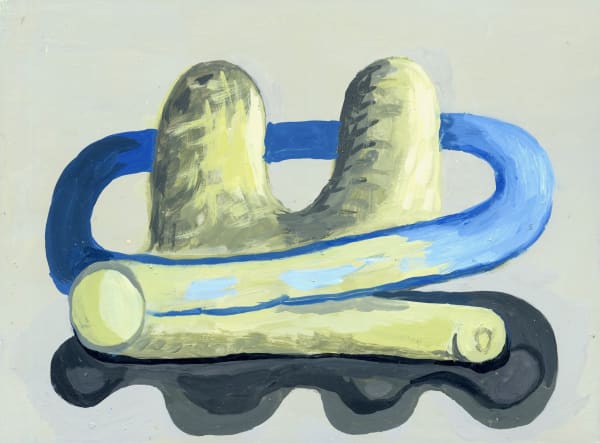Christine Hughes was born in 1955. Her career was seeded in Detroit, where she was influenced by the artists of the Cass Corridor. After receiving her BFA from Wayne State University in 1981 she moved to New York City. She maintained a studio on Canal Street in Chinatown until she moved to the Hudson Valley in 2002.
She has shown prolifically in both New York and Detroit, including exhibitions at The Drawing Center (NYC), Bard College, Annandale on Hudson, The Samuel Dorsky Museum (New Paltz, NY), The Millay Colony (Austerlitz, NY), The Willis Gallery and Alley Culture in Detroit. She has had one person shows at John Davis Gallery (Hudson, NY), Art101 (Brooklyn, NY), and The Foundation Gallery (Hudson, NY).
The artist refers to her small paintings as “physical abstractions”. These paintings are slow moving, anti-heroic studies. Using a limited palette, they are iconic in their central imagery, intimate in scale, reductive in their simplicity, and often both humorous and anxious.
Hughes received the Pollock-Krasner Grant in 2022.
-
All works:Enamel on paper.6 x 8 in. (15.2 x 20.3 cm.)$2,500 ea.
-
"I attended Wayne State University and fell in with a group of hard-working artists whose sensibilities I shared. Their work was visceral, stark paletted, and rough edged. No fancy materials here. There were show downs, get a pencil and draw your way out of this, and so on. It was a pretty macho group. When I’d had my fill, I moved to New York City ... In New York I became much more monastic, and I developed my own voice and vision."
-
"I chose the size of 6 x 8 inches inspired by work a friend had done at this scale. It seemed the perfect size for experimenting. My idea was to paint with no point of reference. Normally, I work from a drawn image or a setup. In these paintings I wanted to see what would happen with no image in front of me, or in my mind."
-
"the idea of sequestering and the uncertainty of how Covid was transmitted made me focus on these small paintings more than ever. The immediacy and intimacy of working on this scale was perfect for me."
-
"I began each painting on a ground of gray enamel. From there I would mix a color and paint a form. In much of the early work the shapes were more biomorphic and as the work evolved it became more symmetrical and more formal. I’ve painted exclusively with enamel for many years ... The way I work the paint has to be built-up in layers. It’s fluid until it’s half dry, then the surface becomes gummy. The colors change to at least a shade darker as they dry. But, the surface is so beautiful and this paint dries overnight so I can work on a painting every day."
-
"The forms in these paintings are familiar to the viewer, to some degree or another, but abstracted from thingness, more evocative than actual. Some forms are contradictory to each other, space flattened out. I am focused on the balance of the forms and the tension between the hand painted line I love, and the too tight, dry, abstraction I am trying to avoid."
-
"I want this work to remain evocative, so the titles give just a suggestion of structure ... In a sense many of the titles are a shorthand of recollection or a poetic fragment from my past."















